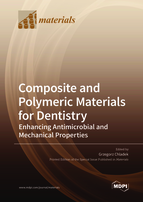Composite and Polymeric Materials for Dentistry: Enhancing Antimicrobial and Mechanical Properties
A special issue of Materials (ISSN 1996-1944). This special issue belongs to the section "Biomaterials".
Deadline for manuscript submissions: closed (20 May 2022) | Viewed by 79896
Special Issue Editor
Interests: dental materials; biomaterials; polymers; composites; antimicrobial materials; nanomaterials; mechanical properties; denture; implants; dental caries
Special Issues, Collections and Topics in MDPI journals
Special Issue Information
Dear Colleagues,
Billions of people suffer from dental problems, and that number is permanently increasing. The main reasons behind this are dietary habits and social determinants, so an immediate change to this challenge should not be expected. Paradoxically, the deteriorating state of teeth is accompanied by the ever-increasing desire to preserve the best facial appearance, which is significantly influenced by teeth aesthetics. This favors the dynamic development of dental materials and manufacturing technologies for dental prosthetics, needed to achieve expected effects of clinical treatment.
This Special Issue will focus on enhancing antimicrobial and mechanical properties of polymeric materials and composites for dentistry. In recent years, special attention has been focused on the possibility of giving materials new or improved properties by the introduction of nano or submicron size additives, such as particles, fibers or whiskers. Using agents like natural oils to enhance antimicrobial properties remains an exciting idea. Another area of research is the application of antibacterial monomers, which can be copolymerized in resins to kill oral pathogenic microflora. The use of new monomers or new compilations of various monomers to improve mechanical properties has also aroused interest. In addition, we are currently looking for new data regarding colonization of dental materials by pathogenic microbes and their influence on the other properties. Further, there are many new commercially available materials which should be investigated to verify their properties, which is important from the point of view of clinical practice. For this purpose, we invite you to submit a manuscript for this Special Issue. Original research articles and reviews related to any of the topics mentioned above are welcome.
Prof. Grzegorz Chladek
Guest Editor
Manuscript Submission Information
Manuscripts should be submitted online at www.mdpi.com by registering and logging in to this website. Once you are registered, click here to go to the submission form. Manuscripts can be submitted until the deadline. All submissions that pass pre-check are peer-reviewed. Accepted papers will be published continuously in the journal (as soon as accepted) and will be listed together on the special issue website. Research articles, review articles as well as short communications are invited. For planned papers, a title and short abstract (about 100 words) can be sent to the Editorial Office for announcement on this website.
Submitted manuscripts should not have been published previously, nor be under consideration for publication elsewhere (except conference proceedings papers). All manuscripts are thoroughly refereed through a single-blind peer-review process. A guide for authors and other relevant information for submission of manuscripts is available on the Instructions for Authors page. Materials is an international peer-reviewed open access semimonthly journal published by MDPI.
Please visit the Instructions for Authors page before submitting a manuscript. The Article Processing Charge (APC) for publication in this open access journal is 2600 CHF (Swiss Francs). Submitted papers should be well formatted and use good English. Authors may use MDPI's English editing service prior to publication or during author revisions.
Keywords
- Dental materials
- Polymers
- Composites
- Antimicrobial properties
- Mechanical properties
- Nanomaterials
- Biofilm
- Orthodontic materials
- Prosthetic materials







